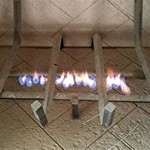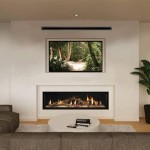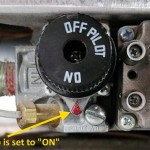Outdoor Fireplace Propane Insert: A Comprehensive Guide
An outdoor fireplace can significantly enhance the ambiance and usability of any outdoor living space. It provides warmth, a focal point for gatherings, and extends the enjoyment of patios and decks into cooler seasons. However, traditional wood-burning fireplaces can be inconvenient due to the need for firewood storage, smoke emissions, and the effort required for cleaning. An outdoor fireplace propane insert offers a cleaner, more convenient, and often more efficient alternative.
A propane insert is essentially a self-contained firebox that is designed to be installed within an existing or newly constructed fireplace structure. It operates by burning propane gas, providing a realistic flame and radiant heat. These inserts offer various advantages over wood-burning models, making them a popular choice for homeowners seeking a low-maintenance and readily accessible outdoor heating solution.
This article will delve into the key aspects of outdoor fireplace propane inserts, including their benefits, features, installation considerations, safety precautions, and maintenance requirements. A thorough understanding of these factors will empower individuals to make informed decisions when selecting and utilizing a propane insert for their outdoor fireplace.
Key Point 1: Advantages of Propane Inserts Over Wood-Burning Fireplaces
The primary advantage of an outdoor fireplace propane insert lies in its convenience. Unlike wood fireplaces, propane inserts eliminate the need to source, store, and haul firewood. This is particularly beneficial for individuals with limited storage space or those who prefer a hassle-free heating option. With a propane insert, the user simply needs to connect the unit to a propane source – either a portable tank or a direct gas line – and ignite the flame with the push of a button or flip of a switch.
Another significant benefit of propane inserts is their cleanliness. Propane combustion is significantly cleaner than wood combustion, producing little to no smoke, ash, or creosote. This eliminates the smoky smell associated with wood-burning fireplaces and reduces the need for frequent cleaning. The absence of airborne ash and particulates also benefits individuals with respiratory sensitivities.
Furthermore, propane inserts offer greater control over the flame intensity and heat output. Many models feature adjustable settings that allow users to customize the flame height and heat level to suit their preferences. This is a significant advantage over wood-burning fireplaces, where controlling the fire's intensity can be challenging. The ability to precisely regulate the heat also contributes to greater fuel efficiency.
Finally, propane inserts often offer enhanced safety features compared to traditional wood fireplaces. Many models include safety shut-off valves that automatically cut off the gas supply if the flame is extinguished or if a leak is detected. This reduces the risk of gas leaks and potential explosions. Some models also feature protective screens or barriers to prevent accidental contact with the flames.
Key Point 2: Essential Features and Considerations When Choosing a Propane Insert
Selecting the right outdoor fireplace propane insert requires careful consideration of several essential features and factors. One of the most important considerations is the size and BTU (British Thermal Units) output of the insert. The size of the insert should be proportional to the fireplace opening, and the BTU output should be sufficient to provide adequate heat for the desired area. A larger outdoor space will require a more powerful insert with a higher BTU rating.
The ignition system is another crucial feature to consider. Propane inserts typically utilize either a manual spark ignition or an electronic ignition system. Manual spark ignition requires the user to manually create a spark to ignite the gas, while electronic ignition systems offer a more convenient push-button or remote-controlled ignition. Electronic ignition systems often include a pilot light that maintains a small flame to ensure easy and reliable ignition.
The aesthetics of the propane insert are also important. Inserts are available in a variety of styles and finishes to complement different outdoor décor. Some models feature realistic-looking artificial logs, while others offer a more contemporary design with glass or stone media. The choice of media can significantly impact the aesthetic appeal of the fireplace.
The type of fuel connection is another critical consideration. Propane inserts can be connected to either a portable propane tank or a direct gas line. Portable tanks offer greater flexibility and portability, while direct gas lines provide a more permanent and convenient fuel supply. If connecting to a direct gas line, it is essential to consult with a qualified gas technician to ensure proper installation and compliance with local codes.
Finally, the safety features of the propane insert should be carefully evaluated. Look for models with safety shut-off valves, protective screens, and other features that enhance safety. Ensure that the insert is certified by a reputable testing agency, such as UL or CSA, to ensure that it meets established safety standards.
Key Point 3: Installation, Safety, and Maintenance of Propane Inserts
Proper installation is crucial for the safe and efficient operation of an outdoor fireplace propane insert. While some individuals may be comfortable with basic DIY projects, it is generally recommended to hire a qualified professional to install the insert. A professional installer will have the expertise to ensure that the insert is properly connected to the propane source, vented, and installed in accordance with local codes and manufacturer's instructions.
When installing a propane insert, it is essential to ensure adequate ventilation. Propane combustion produces carbon dioxide and water vapor, which must be properly vented to prevent the buildup of harmful gases. The fireplace structure should be designed with adequate ventilation openings to allow for the free flow of air. It is also important to ensure that the venting system is properly installed and maintained.
Safety precautions are paramount when operating a propane insert. Always follow the manufacturer's instructions carefully and never attempt to modify or alter the insert in any way. Keep flammable materials away from the fireplace and never leave the fireplace unattended while it is in operation. It is also important to inspect the propane connections regularly for leaks. If a leak is detected, immediately shut off the gas supply and contact a qualified gas technician.
Regular maintenance is essential to ensure the long-term performance and safety of a propane insert. Clean the insert regularly to remove any debris or soot that may accumulate. Inspect the burner and ignition system periodically to ensure that they are functioning properly. Check the propane connections for leaks and replace any worn or damaged parts. It is also recommended to have the insert professionally inspected and serviced annually by a qualified technician.
Proper storage of propane tanks is essential for safety. Propane tanks should be stored in a well-ventilated area away from direct sunlight and heat sources. They should also be stored in an upright position and secured to prevent them from tipping over. Never store propane tanks indoors or in enclosed spaces.
In conclusion, outdoor fireplace propane inserts offer a convenient, clean, and efficient alternative to traditional wood-burning fireplaces. By carefully considering the features, installation requirements, safety precautions, and maintenance guidelines, individuals can enjoy the warmth and ambiance of an outdoor fireplace without the hassle of firewood and smoke.

Outdoor Gas Fireplaces Valor

42 Outdoor Gas Fireplace Electronic Ignition Fine S

Superior 36 Stainless Steel Outdoor Propane Gas Fireplace Vre4336 The
.aspx?strip=all)
5 Benefits Of Outdoor Fireplaces Regency

Enviro E Series Gas Or Propane Insert Fireplace Fireplaces By Cameron

Choosing The Right Gas Fire Pit Insert Firefarm Living

How To Choose An Outdoor Fireplace The Home Depot

Outdoor Propane Wood Burning Fireplaces Real Flame

Propane Fire Pits Why You Might Want One Pgagnon

Outdoor Fireplace Kits Stonewood S Cape Cod Ma Nh Ct








